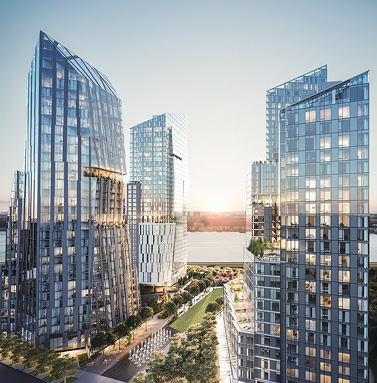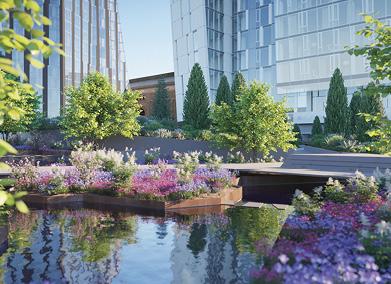- Home
- Media Kit
- Current Issue
- Past Issues
- Ad Specs-Submission
- Ad Print Settings
- Reprints (PDF)
- Photo Specifications (PDF)
- Contact Us

![]()
ONLINE

One-of-a-Kind Developments
Editors’ Note
James Linsley is the President of GID Development Group. Linsley has more than 25 years of real estate experience and has been involved in all aspects of mixed-use real estate development and numerous projects totaling approximately $20 billion in development value and 40 million square feet across virtually all asset classes. Prior to GID, Linsley worked with several of the nation’s most high-profile real estate organizations. As a Senior Vice President with Related Companies, Linsley worked from concept to completion on developments throughout the United States, including Time Warner Center, the iconic 80-story, $2-billion, mixed-use project in New York City. Linsley holds a B.A. in Architecture and a B.S. in Civil Engineering from Lehigh University. He also holds an M.S. in Real Estate Development and an M.S. in Urban Planning from Columbia University.
Company Brief
With offices in New York City, Boston, San Francisco, Washington, DC, Dallas, and Denver, GID (gid.com) estate organization founded in 1960 that owns and manages a premier portfolio of existing properties and development projects valued at over $16 billion. GID Development Group is a wholly owned affiliate of GID that is currently involved in 23 development projects in nine states with approximately 10,000 residential units and two million square feet of commercial space. GID Development Group, under the leadership of Linsley, was formed in 2007 to develop sophisticated “best-in-class” mixed-use projects and iconic residential urban developments throughout the United States that combine high-quality design with one-of-a-kind residential, retail, restaurant, office, hotel, cultural, and public space offerings.

View of the Waterline Square development
on Manhattan’s Upper West Side
Will you describe the heritage of GID and how it has evolved to where it is today?
GID and I started speaking in 2006 about creating a mixed-use and luxury residential development platform. In 2007, we consummated that, and I joined GID. It was interesting timing, of course, and that had its pros and cons.
In hindsight, it might not have been a bad thing. We were able to get some really high-quality team members on board because it was happening during the recession.
It was a new development platform being done at a very high level and being backed by a very well-capitalized and long-term player in the business.
Another plus of doing it then was that it allowed us to pursue some interesting land transactions and get some interesting projects into our pipeline when others weren’t looking at the long-term potential in quite the same way.
Although we had ambitions to do large-scale, mixed-used projects, it became apparent that the part of the industry that was emerging the fastest out of the downturn was multifamily, so we started to pursue more luxury multifamily projects and to build those early in the cycle. We were able to get advantageous construction pricing, and we were building at a time when there wasn’t a lot of other supply, so the rents started to escalate and we hit it just right.

View of the Waterline Square development
on Manhattan’s Upper West Side
We began to pursue larger projects throughout the country and started developing high rises in Texas and Seattle at great one-of-a-kind sites. We aligned ourselves with long-term programmatic relationships with equity partners with some of the world’s largest pension funds and sovereign wealth funds on the development side of the business, and we began pursuing projects that are one-of-a-kind iconic, trophy developments, which were very large.
Looking back to when we started, we have been involved in 36 development projects in nine states including projects completed or in the development process, encompassing approximately 14,000 residential units, two million square feet of commercial space, and $10 billion in development value.
We’re probably one of the most well-capitalized and active private development organizations in the country, but we’re fairly quiet about it.
Is brand important to GID or is it more about individual property projects?
It’s important to us, and we’re becoming more prominent as a brand. I’m a big believer in authenticity. I’m not sure if it’s because of social media or the speed of information, but today everyone claims to have the most or be the best of something. If it’s declared enough, it is perceived as so, but it’s not always authentic.
However, looking at what we’ve achieved, we can go forth with confidence. We don’t need to shout from the rooftops too loudly. Our record speaks for itself in terms of what we are capable of doing.
Will you discuss the impact of the Waterline Square project?
What attracted us to those sites initially is they represented perhaps the last waterfront development sites on the Upper West Side of Manhattan and the only waterfront development sites that link Midtown and the Upper West Side. We were looking at them at a time when we viewed the development growth pattern of Manhattan to be shifting westward, and it was also happening at a time when some of the most expensive real estate in the world was marching westward.
We were on this threshold between Midtown and the Upper West Side, linked back to Columbus Circle and Central Park, and we were the last piece of the Riverside South master plan that spanned from 59th to 72nd Street. To be able to come in and be the last site to complete that master plan and fill that neighborhood void in a cohesive way was a magical thing.
Our goal in putting this together was to create the most unique, comprehensive, and cohesive residential living experience in New York City. We hired real, world-famous New York City architects to preserve that feeling including Rafael Viñoly Architects, Richard Meier & Partners Architects, and Kohn Pedersen Fox Associates. Each building has its own unique identity, but there are architectural elements that connect them. We also wanted outstanding interior designers that would work well with the architects, so the entire space will really come together cohesively.
Do significant opportunities continue to exist across the country for GID and will there also be international opportunities?
As a company, GID does have an international arm, although my group doesn’t handle that. We anticipate opportunities in multiple regions throughout the country. We’re always interested in 24/7 gateway cities with the right balance of density, population, and job trends.
With so much luxury supply in New York, is there adequate demand to meet it?
On the super-luxury end of the market, there appears to be a supply/demand imbalance to some degree. We consciously didn’t go for that super-luxury product, so what we’re delivering is differentiated from the marketplace in terms of the scale of what we’re doing, the quality of the architecture and design, the magnitude of the amenities, the type of amenities we’re delivering, and the fact that we’re delivering it all at once.
There isn’t anything like it in the city, and it would be difficult to replicate what we’ve done elsewhere.•